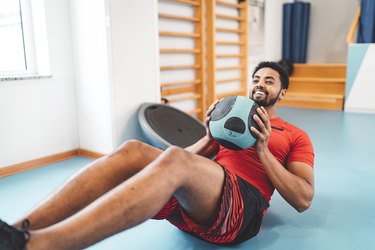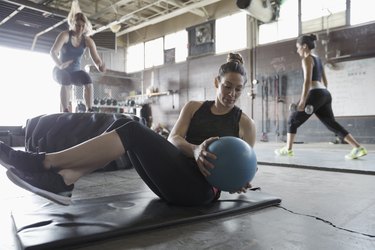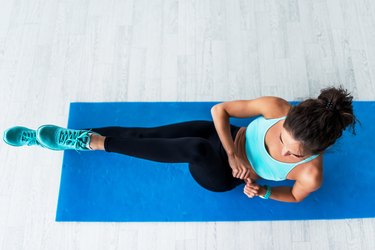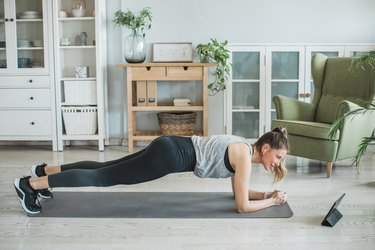

Carving an enviable six-pack isn't an easy feat — which is too bad, because it seems nearly everyone wants a defined set of abs. But too many people view a sculpted midsection as a kind of status symbol, reserved for the genetic elite or those who spend more time doing ab workouts than anything else. And that's simply not the case.
Yes, your genetics and diet influence how much muscle definition and how little body fat you have around your midsection. But here's the thing: Everyone has abs — regardless of how well you can see them — and that means everyone can build stronger midsections.
Video of the Day
You might have to relearn a few things (nothing worth having ever came easy, right?), but by incorporating the principles below and trying some new exercises, you can create the ultimate ab workout.
What Makes the Best Ab Workout?
Ever wonder why sit-ups became such a popular exercise? Often, anatomy books state that the purpose of your abdominal muscles is to flex your spine. As a result, many think that by creating a "crunch" type movement, you'll build your abs the way nature intended.
Unfortunately, most anatomy books are at least 35 years out of date, says Mark Comerford, a researcher, physical therapist and founding director of Kinetic Control, a consulting agency that assists physiotherapists. While your abs do flex your spine, that's only one part of their job.
Your core is more than just your abs — it includes layers of muscles that help support your back, hips, butt and stomach.
Your core muscles also help:
Create movement: If you're standing upright and bend forward at your waist as fast as you can — like a boxer ducking a punch — you'll feel your abs activate.
Counterbalance movement: If you were to start leaning backward from standing, you'll again feel your abs activate, but this time in a different way. Your abs are doing the opposite of what anatomy books tell you. Rather than flexing your spine, those muscles are fighting the extension of your spine to keep you from falling over.
Resist movement: Imagine you're standing upright with your arms reaching straight out at shoulder height, hands locked together. If a friend were to push your arms to one side, how would you resist their efforts? Your abs.
Rotational movement: Imagine you're facing forward and twisting your torso to the right. Your core helps you rotate your torso while keeping your spine and pelvis safe.
In order to build an effective ab workout, it's crucial to challenge your entire core in all of these different forms and motions. That's because almost every movement you do — both during your workouts and in your daily life — engages your core in some capacity, according to Harvard Health Publishing.
Press a weight overhead? Your core is engaged. Stand on one leg? Your core is working. Struggle during a tough exercise and "cheat" a little on your form? Yep, you'll probably feel your core coming to the rescue.
What Are the Most Effective Ab Exercises?
It's the ultimate question for fitness fans: What's the best ab exercise? Bicycle crunches, captain's chair (aka knee raises) and stability ball crunches are three of the most effective ab exercises, according to widely cited 2001 research sponsored by the American Council on Exercise (ACE).
Here's how to do those some of those moves.
1. Bicycle Crunch
- Lie on your back with your hands behind your head, elbows out.
- Raise your head, neck and shoulders off the floor by engaging your abs.
- Twist to your left side, bending your right knee in toward your chest as you bring your left elbow to meet it.
- Return to center and repeat with the opposite arm and leg.
2. Hanging Knee Raise
- Hold onto a pull-up bar at about shoulder-width distance.
- Keeping your body steady and arms straight, bend your knees to a 90-degree angle, pulling them up toward your chest.
- Hold here for a moment.
- Reverse the motion and straighten your legs back to the starting position.
3. Swiss Ball Crunch
- Lie face-up with your lower back supported on top of the stability ball, feet flat on the floor and knees bent to 90 degrees.
- Raise your head and shoulders and pull your rib cage toward your pelvis.
- Hold briefly, then return to the start.
Building an Effective Ab Workout Routine
While endless crunches might not be the best approach (see below for more on that), if you're strategic about the ab exercises you choose, you can create an incredibly effective core workout.
Incorporating a stability ball is an excellent tool for strengthening your midsection, and it can be used in lower-ab exercises and oblique-sculpting moves.
Adding this tool to your ab workout at home has benefits for your entire core because it helps you target all the functions of the trunk, including flexion, extension, side-bending and rotation, according to the ACE.
Try this four-move routine the next time you need an ab workout at the gym or at home.
1. Swiss Ball Plank
- Start in a push-up position with your hands on top of a Swiss ball.
- Come down to your elbows, keeping your legs straight, body in a line from head to hips to heels.
- Keeping your core tight, hold this position.
2. Swiss Ball Pike Rollout
- Start in a push-up position with your hands under your shoulders and shoulder-width apart on the floor, feet resting on top of a Swiss ball.
- Tighten your core muscles and lift your hips in the air, keeping your legs straight. Your feet should roll along the ball until your toes are the only parts touching it.
- Pause here briefly.
- Lower yourself back down, sliding your legs back over the ball until the tops of your feet are resting on the ball again.
Tip
Remember to keep your abs braced and your back straight throughout the movement.
3. Swiss Ball Crunch
- Lie face-up with your lower back on the stability ball, feet flat on the floor and knees bent to 90 degrees.
- Raise your head and shoulders and pull your rib cage toward your pelvis.
- Hold briefly, then return to the start.
4. Swiss Ball Push-Up
- Come to a high plank with your hands on the ball beneath your shoulders.
- Exhale as you bend your elbows and lower your chest until it touches the ball
- Push back up into a plank.
How Many Times a Week Should You Do an Ab Workout?
Unlike other muscle groups that need 48 hours to recover in between workouts, you can do ab work every day if you want.
Just watch your intensity: If your version of an ab workout includes deadlifts and medicine ball tosses, you'll want more time to recover between sessions. However, body-weight core exercises like planks, dead bugs and bird dogs are generally OK to do every day.
So, Are Crunches Good or Bad for Abs?
In recent years, crunches and sit-ups have gotten a bit of bad press, as fitness experts and rehab professionals began speaking out against the exercise. Stuart McGill, PhD, a spine researcher at the University of Waterloo, found indications that performing too many crunches (or doing them too frequently) could cause a person's spinal discs to push out too far, causing pain and potentially a herniated disc.
Claims like this regarding the effect of crunches are highly debated. Carl DeRosa, PhD, founder of DeRosa Physical Therapy, says your body position isn't responsible for putting pressure on your discs — it's how tightly you squeeze (or compress) your muscles.
Other experts, like spinal researcher Michael Adams, PhD, say a person's discs can actually strengthen (like your muscles) and potentially become more resilient to injury as a result of doing ab exercises like crunches properly.
The bottom line: If you have a disc-related injury, crunches might not be the best exercise for you. But for healthy athletes, a few sets (not hundreds of reps) of well-performed crunches can help activate your abs. Just don't rely on them as your sole form of ab exercise.
How Do You Get a Six-Pack Fast?
So, can you just do a bunch of bicycle crunches, hanging leg raises and Swiss ball crunches and wake up one morning with six-pack abs? Not so fast. There's no such thing as "the best ab workouts for quick results." Ab exercises alone won't banish belly fat to reveal amazing abs underneath — you still need to be burning more calories than you take in to shed body fat.
Chiseling your midsection requires a concerted effort that involves overhauling both your workouts and your nutrition (and often, a little help from your genetics).
First, you'll need to clean up your diet and cut calories to reduce your overall body fat percentage. That often means limiting highly processed foods and alcohol and prioritizing lean protein, fresh vegetables, complex carbs and healthy fats.
Next, you'll need to make sure you're doing cardio. The higher the intensity, the more calories you'll burn. You can either opt for longer, steady-state bouts (like going for a long run) or shorter sessions of high-intensity interval training (HIIT). And lastly, yes, you'll need core-specific exercises, like planks, bird dogs and leg raises.
There is no one "best" exercise to lose belly fat, and reducing belly fat requires more than exercise. You can't spot reduce belly fat. Rather, you'll lose body fat all over with a combination of regular physical activity, a nutritious diet and other healthy habits like getting enough sleep.
Try one of the workouts below:
- Harvard Health Publishing: "The Real-World Benefits of Strengthening Your Core"
- American Council on Exercise: "Core-Strengthening Stability Ball Workout"
- American Council on Exercise: American Council on Exercise (ACE)-sponsored Study Reveals Best and Worst Abdominal Exercises
- Sports Medicine: Effect of High-Intensity Interval Training on Total, Abdominal and Visceral Fat Mass: A Meta-Analysis.
- Research Quarterly for Exercise and Sport: Effects of Sit-Up Exercise Training on Adipose Cell Size and Adiposity
Was this article helpful?
150 Characters Max
0/150
Thank you for sharing!
Thank you for your feedback!



